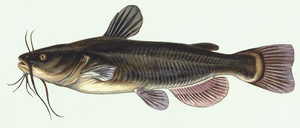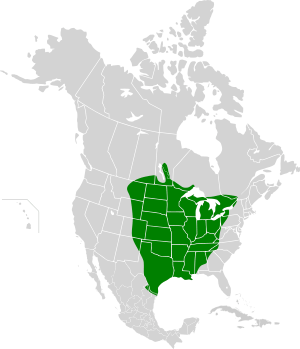Black bullhead facts for kids
Quick facts for kids black bullhead |
|
|---|---|
 |
|
| Conservation status | |
| Scientific classification | |
 |
|
| Global range of A. melas | |
| Synonyms | |
|
The black bullhead (Ameiurus melas) is a type of bullhead catfish. These fish are amazing because they can live in tough conditions. They do well in water that has low oxygen, is a bit salty, muddy, or even very warm. Black bullheads have special whiskers called barbels near their mouths. They also have a wide head, spiny fins, and no scales.
You can tell a black bullhead apart from other bullheads by its black barbels. It also has a light tan curve around its tail. Its tail fin looks squared off at the ends. Like most catfish, black bullheads are active at night. They prefer to find food when it's dark. Young bullheads, however, might feed during the day.
Black bullheads are usually smaller than channel or blue catfish. Most adults weigh about 1 to 2 pounds. They almost never get as big as 4 pounds. A typical black bullhead is 8 to 14 inches long. The largest one ever found was 24 inches, making it the biggest bullhead. Their bodies are usually black or dark brown on top. Their bellies are yellow or white.
Like many bullheads, they have a squared tail fin. This is different from the forked tails of channel and blue catfish. Black bullheads are "bottom-rovers." This means they are great at living on the bottom of lakes and rivers. Their bodies are a bit flat from top to bottom, and they have a slightly humped back. Their color can change depending on where they live. But they are usually darker than brown or yellow bullheads. You can tell them apart from a flathead catfish because the black bullhead's lower lip does not stick out.
It can be a bit tricky to tell a black bullhead from a brown bullhead. One way is to look at their pectoral spine. The black bullhead's spine is almost smooth. The brown bullhead's spine is very rough. The black bullhead's anal fin also has a gray base. Its tail has a light bar. Brown bullheads usually have 21 to 24 soft rays in their anal fin. Black bullheads have 17 to 21. Brown bullheads are also often mottled brown and green on top. Black bullheads are darker. You can easily tell both black and brown bullheads from yellow bullheads. Yellow bullheads have white barbels under their mouths.
| Top - 0-9 A B C D E F G H I J K L M N O P Q R S T U V W X Y Z |
Where They Live
Black bullheads are found across the central United States. They often live in still or slow-moving water. They like places with soft, muddy bottoms. Sometimes, you can find many of them together. They might gather in tight spots like lake outlets or under dams. These fish are very tough. They can live in muddy water, warm water, and water with low oxygen. This helps them avoid competition from other fish. Black bullheads are also found in many parts of Europe. There, they are considered an invasive species. This means they are not native and can cause problems for local fish.
What They Eat
Black bullheads are omnivores. This means they eat almost anything! Their diet includes plants, insects, dead or living fish, and small crustaceans. Adult bullheads mostly eat midge larvae and other young insects. They have also been known to eat small fish and fish eggs. They have short, pointed teeth arranged in many rows.
Black bullheads do not have scales. Instead, they have about 100,000 taste receptors all over their bodies. Many of these are on the barbels near their mouths. These taste receptors help them find food in dark places. In winter, black bullheads eat less food. They might even stop eating completely. They bury themselves in debris near the lake shore. Only their gills are exposed. This "hibernation" helps them survive when oxygen is low and temperatures are cold.
How They Reproduce
Black bullheads start to lay eggs in April and continue until June. The female digs a small hole in the lake bottom. She lays between 2,000 and 6,000 eggs. The male then fertilizes the eggs. He also takes care of them. The eggs hatch about a week later. Both parents watch over the young fish, called fry, for a short time.
Fishing for Black Bullheads
Black bullheads are not as popular for sport fishing as channel or blue catfish. This is because they are smaller. However, their meat is light in color and tastes great when the water is clean. The meat around the belly and gills of larger fish can have a strong taste. This is due to yellow fat. But you can avoid this by removing those fatty parts when cleaning the fish. Black bullheads are the largest of the bullheads. They are sometimes called "mud catfish."
These fish have been introduced to many areas in the U.S. This is because they can survive in tough conditions. But they are not often used in fish stocking programs. This is because they are not as desirable as other fish. Fisheries experts often don't recommend them. They compete with fish like bluegill and channel catfish for food. They also don't grow as fast or as big as channel catfish. Because of this, it's hard to buy them for stocking ponds.
However, in clean water, their meat quality is very good. Unlike channel catfish, black bullheads can reproduce and keep their numbers healthy in ponds. This is true even in ponds with bass and crappie. In fact, like bluegill, a pond with black bullheads needs a predator fish like bass. This helps keep the bullhead population under control. Because they can reproduce in a pond with bass, bullheads are a good catfish for ponds with mixed fish. This is especially true if the pond isn't fished out and restocked often.
You can catch black bullheads using similar methods as for channel or blue catfish. But their smaller size might mean you need smaller bait and hooks. They like earthworms. They also tend to feed higher up in the water than channel catfish. Like most catfish, they are most active at night. They are less active during the day. They often rest under piers or in shady areas along the shore. In some places where there isn't much fishing, black bullheads have been caught using metal spoon lures.
How They Defend Themselves
Black bullheads have spines at the base of their pectoral and dorsal fins. They can use these spines like sharp spurs to cut predators.
Images for kids
See also
 In Spanish: Ameiurus melas para niños
In Spanish: Ameiurus melas para niños




